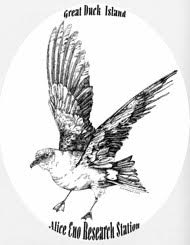
Where Do Gulls Go?
by Addison Gruber
The Gulls
Herring gull (Larus argentatus) with a color band
The adult herring gull (Larus argentatus) has a light gray back and wings tipped with black. Their yellow beak has a characteristic red spot used by the young to beg for food. They can weigh over one kilogram (2.2 pounds) Herring gulls are found around the world, not only by the sea, despite often being called "seagulls". There is debate over the herring gull's taxonomic status. American ornithologists lump herring gulls in North America and Europe, while European ornithologists split them. They are often described as scavengers, though there is evidence that individual herring gulls specialize on particular food sources (intertidal, aquaculture, ocean, anthropogenic, freshwater).
Great black-backed gull (Larus marinus) with a chick under its wing
The great black-backed gull (Larus marinus) is the largest species of gull in the world. They have very dark wings and back and are larger than any gulls around! They also have a red spot on their yellow bill. They are found in North America and Europe. They feed and forage on a variety of sources.
The Island
Great Duck Island is a 91-hectare island located in the Gulf of Maine, 15 kilometers south of Mount Desert Island, Maine. The island is home to perhaps the continental United States' largest colony of Leach's storm petrels, and to a colony of herring and black-backed gulls who nest here in the summer. Ongoing research has been conducted on gulls on the island since 1999. There are roughly 1200 nesting pairs on the island, though this has been declining in recent years. Gulls have increasingly been nesting on the south end of the island around the field station and lighthouse.
College of the Atlantic acquired the light station in 1998 under the Maine Lights Program, and has a cooperative agreement with The Nature Conservancy and the State of Maine to act as a warden to the island. Since 1999 students have been conducting research on the island from June to August. Research from birds to trees to flora to bees to geology and more have happened on the island. Long-term research has focused on the island's seabirds, particularly gulls and the Leach's storm petrel.
View of Great Duck Island from the south. Photo courtesy of Michael Cornish, July 2016
Banding
Federal bands on a string, ready to be deployed
To give the birds individual identifiers they are banded. Most common are the small, metallic federal bands. On each band is a unique eight or nine-digit string of numbers. They are provided by the US Geological Survey's Bird Banding Lab, and are inscribed with WWW.REPORTBAND.GOV, where you can report any bands you see! The Bird Banding Lab relays to the bander reports of their birds and the information you provide.
Crew member putting a federal band on a chick
The chick-check team at the Alice Eno Field Station sends out federal bands on chicks in the nests they study when they are big enough. This allows researchers to keep track of individual chick growth over the summer, and to identify birds who come back to the island.
Color band being placed on a gull
Once the birds are large enough they can receive a color band made of colored plastic. Color bands have a three-digit letter-number-letter combination. These larger, more obvious bands are easier to spot. Birds from Great Duck Island and Mount Desert Rock have maroon bands with white lettering.
Gull chicks with federal and color bands. Photo courtesy of Wriley Hodge, 2021
Great black-backed gull with federal and color bands
Great black-backed gull with federal and color bands
Leaving the Nest
At the end of the summer fledglings take flight and birds take off--but where do they go? Based on information from bands reported to the USGS Bird Banding Lab, this is what we know.
Reported sightings of birds on Great Duck Island. Zoom in to see where the birds have gone!
Our Great Duck Island gulls have been seen as far west as Louisiana, east to Bermuda, south to Florida, and north to Nova Scotia and New Brunswick.
Hotspot map of all reported gull sightings. Click on the map to interact
Most of our gulls were reported in the northeastern United States. Click on the map at the right to explore hotspots of gull activity.
By species
Both herring gulls and great black-backed gulls are present on Great Duck; herring gulls are the more numerous of the two.
Impact of banding
How old are the gulls?
For those birds banded as chicks, we know about how old they are based on the banding date and the date they were seen and reported. For those banded as adults, we only know their minimum age at the time they were seen and reported. Here approximate chick age is shown by the yellow-red circles. Many reported gull sightings are of gulls in their first year, shown by the lightest yellow. We also get reports of gulls up to 20 years old!
Minimum ages for chicks and adults banded on Great Duck Island. Those ages for chicks are more accurate than adults, as the exact age of adults at the time of banding is unknown. Click on the icon in the bottom left corner to open the legend, interact with the map
To Learn More
To learn more about Great Duck Island and our research visit our website.
For more information about this project contact the author, Addison Gruber, at agruber22@coa.edu.